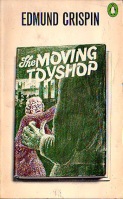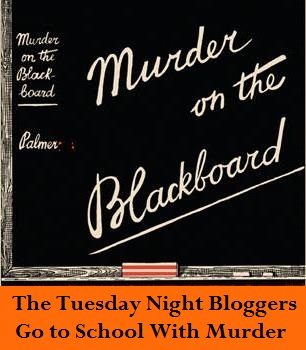Okay, so I’m going to do my best to stay on-task today; none of these wild flights of fancy. A discussion of Golden Age academic mystery and nothing more. And since I already have my post sorted for next Tuesday, and that’s the final week in June, it has to be now that I engage in some discussion about Edmund Crispin and the irrepressible Gervase Fen.
Fen, Oxford don of English Literature at a fictional Oxford University college, should be the world’s most irritating fictional detective but is probably my favourite of all time: a springer spaniel in human form with a persistently cheery outlook and a habit of taking rather too much delight in the complexities of the crimes he investigates. The fourth-wall-breaking for which Fen seems to have become known is an only very occasional feature of the books, and remains sly and delightful, especially in the awkward silence the follows this declaration from The Case of the Gilded Fly (1944):
“Good literary critics are always good detectives. I’m a very good detective myself. In fact, I’m the only literary critic turned detective in the whole of fiction.”
 Most charmingly of all – and I know it doesn’t sound it, it sounds pompous and awful – is the occasional forays Crispin himself makes either directly (see the footnote in Holy Disorders (1945) after Fen is derisory about the reader having to swallow an unlikely plot development, and the joyous two word rebuttal Crispin offers as a footnote again towards the end, as if settling a score on this front) or indirectly (such as Fen “thinking up titles for Crispin” during an exciting moment in The Moving Toyshop (1946), under the – clearly correct – assumption that this will be written up).
Most charmingly of all – and I know it doesn’t sound it, it sounds pompous and awful – is the occasional forays Crispin himself makes either directly (see the footnote in Holy Disorders (1945) after Fen is derisory about the reader having to swallow an unlikely plot development, and the joyous two word rebuttal Crispin offers as a footnote again towards the end, as if settling a score on this front) or indirectly (such as Fen “thinking up titles for Crispin” during an exciting moment in The Moving Toyshop (1946), under the – clearly correct – assumption that this will be written up).
The lightness permeates everything: Fen’s characteristically life-threatening driving of his beloved Lily Christine III (surely one of the most personified non-sentient cars in the realm of fiction), being taken out of the action for a French pilot to roll his eyes at “Le Blackout Anglais” in The Case if the Gilded Fly, the poet Richard Cadogan’s escape from captivity described as simply a list of objects encountered as he flees in The Moving Toyshop, the discovery of a mess which is “indescribable, so shall not be described” in Love Lies Bleeding (1948), the man watched shouldering an imaginary burden through the woodland in Buried for Pleasure (1948)…if Carr has the century’s best mind for hooks and plots (and he did) then Crispin bests everyone in comic touches.
And yet, like the best authors of his ilk, Crispin is able to change tones brilliantly, often discordantly – the background of witchcraft never quite sits that well with everything else going on in Holy Disorders, feeling like a Carr thread woven into a different book – but at times with the force of a kick to the gut. Without revealing too much, the fate of the main perpetrator in Holy Disorders remains one of the moments from all my reading most indelibly printed upon my mind: there’s a force behind that writing, a sudden coldness, that is remarkable for how it contrasts with the tone of the rest of the book and especially the scene preceding it. This can also be found in the non-Fen story ‘The Pencil’ from the posthumous collection Fen Country, a narrative so tough, with an ending so hard-edged, that it read more like Mickey Spillane than the man also known as composer Bruce Montgomery.
 And then, of course, there are the plots. Crispin has shouldered of a late a reputation of a weaver of impossible crimes, but I’m not of the opinion that this does his wild flights of imagination enough favours. The impossible element of The Moving Toyshop comes at the very end of a harum-scarum chase that overflows with creative flourishes unacknowledged by any conventional label. The scheme used in Love Lies Bleeding is preposterously clever, but really boils down to more of an alibi problem – and one Freeman Wills Crofts wold have given his hind teeth for. If the final two of the six books under discussion here – I wish to discuss the last tranche separately, and will probably have to fit time in to review them at some future point to go into the depth I feel they require – come up somewhat lacking in plot, there are still plenty of clever ideas (one involving binoculars, for instance, which may be terrible or may be genius) to make them at least worthy of consideration. Only Buried for Pleasure is outright poor, I’d argue, and that at least has the non-doing pig to keep you entertained…yeah, no, okay, it’s not a good book at all.
And then, of course, there are the plots. Crispin has shouldered of a late a reputation of a weaver of impossible crimes, but I’m not of the opinion that this does his wild flights of imagination enough favours. The impossible element of The Moving Toyshop comes at the very end of a harum-scarum chase that overflows with creative flourishes unacknowledged by any conventional label. The scheme used in Love Lies Bleeding is preposterously clever, but really boils down to more of an alibi problem – and one Freeman Wills Crofts wold have given his hind teeth for. If the final two of the six books under discussion here – I wish to discuss the last tranche separately, and will probably have to fit time in to review them at some future point to go into the depth I feel they require – come up somewhat lacking in plot, there are still plenty of clever ideas (one involving binoculars, for instance, which may be terrible or may be genius) to make them at least worthy of consideration. Only Buried for Pleasure is outright poor, I’d argue, and that at least has the non-doing pig to keep you entertained…yeah, no, okay, it’s not a good book at all.
Curtis Evans, our blogosphere’s The Passing Tramp, has written illuminatingly on Crispin/Montgomery here – well worth checking out for those who wish to know more about this most talented of classic detective authors. And in fact this website has appeared recently, too, so there thankfully seems to be no need of him disappearing from our shelves just yet.
~

Done next week’s post already? You’re definitely getting ahead of the game. I’m going to be looking at a Crispin one next week, as I read his books at the start of my crime fiction reading (so about 3-4 years ago, but considering the amount of the books I have read it feels a lot longer). Looking at my good reads ratings for his books The Moving Toyshop and The Case of the Gilded Fly have high ratings, but so does Buried for Pleasure, which you don’t seem to like at all. Yet for the life of me I can’t remember why I enjoyed it so much – though its humour probably had something to do with it. Another one to re-read at some point.
LikeLike
I loved Buried for Pleasure as well.
The only Crispin book that has disappointed me is The Long Divorce – it’s heavy-handed which you don’t expect from Crispin.
LikeLiked by 2 people
Yay glad it’s just not me who likes BFP. I think it was only some of Crispin’s later novels which I didn’t think were as good.
LikeLike
This is part of why I’m separating those final three books out…there are Themes that I Wish To Explore.
LikeLike
The reason for my being ahead with next week’s post shall become apparent in next week’s post…worry not, this isn’t some hyperorganisation, more a sort of lucky accident. But more on that next week.
Look forward to your take on Crispin. There are a great many sides to his writing, something I failed to bring out in this rather rushed piece, and it’s great to think he’s still available given how relatively minor he was (no TV series, movies, radio programs, plays from his books, after all).
LikeLike
Yes Crispin is deserving of a good adaptation.
LikeLike
I am fascinated by the fact that I read Crispin in his entirety many years ago and cannot remember a thing about any of the books except the carousel at the end of Moving Toyshop – and THAT’S because Hitchcock lifted it for his climax to Strangers on a Train. I know I enjoyed him a lot and laughed a lot . . . so why can’t I remember the damn books?
Anyway, I bought Love Lies Bleeding a few weeks ago and fully intended to read and comment next week, but since you touched on Crispin this week and Kate is writing about him next, I will move on and read this at a later date.
LikeLiked by 1 person
You still should Brad! I’m only looking at The Moving Toyshop.
LikeLiked by 1 person
Bah, fear not the clustering, my friend. Sometimes I think we have so many diverse topics coming out of these blogs that it’s nice when two things of a similar nature appear close together — good to compare opinions, etc. I say go with LLB, don;t shy away from it. Though of course I’m so late replying to this comment that you’ve doubtless read something else by now!
LikeLiked by 1 person
Well . . . I am knee deep in some Norman Berrow which has nothing to do with the topic but I’m enjoying it very much . . .
LikeLike
Hi Brad, which Berrow are you reading at the moment – is it “Don’t Go out after Dark”? I thought I read somewhere on your blog that you have that on your TBR pile..
LikeLike
That’s the one, Jonathan! Only fifty pages in . . .
LikeLike
Happy reading Brad! I liked the book more when I finally finished it; I felt somewhat ambivalent until I hit the end.
LikeLike
By the way, what happened to your Thursday post (23rd June) ?
LikeLike
Apologies, quite a lot going on in the real world at present. Normal service will resume next week. Probably.
LikeLike
Pingback: #107: Vintage Cover Scavenger Hunt Update | The Invisible Event
Pingback: The Moving Toyshop: Edmund Crispin (1946) | His Futile Preoccupations .....